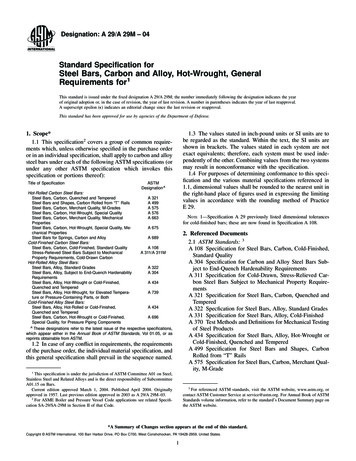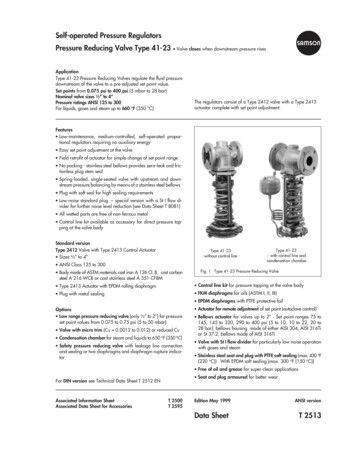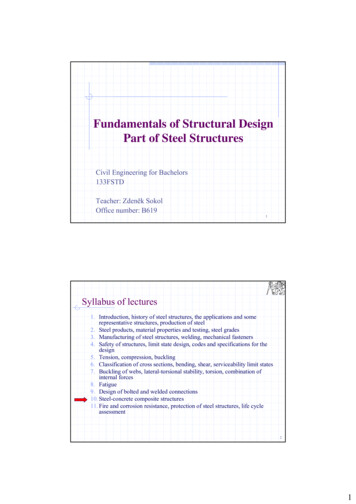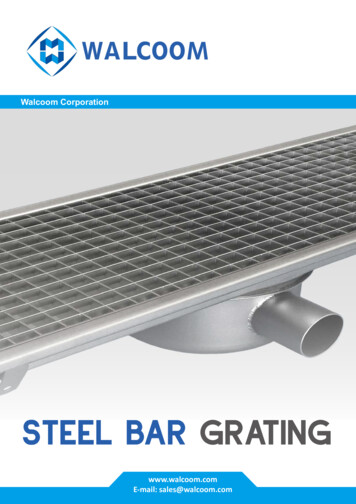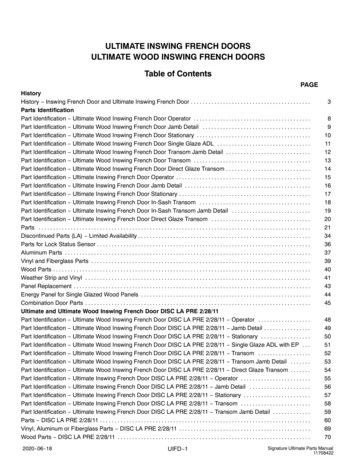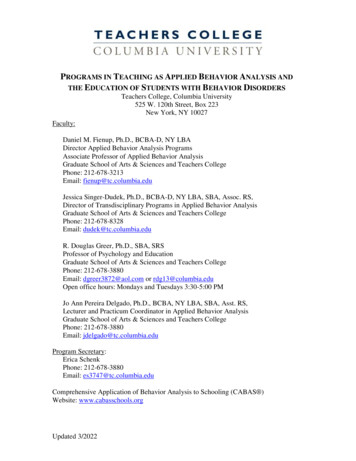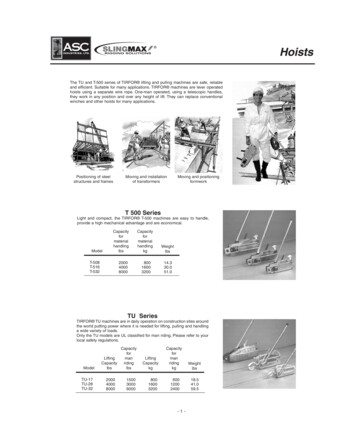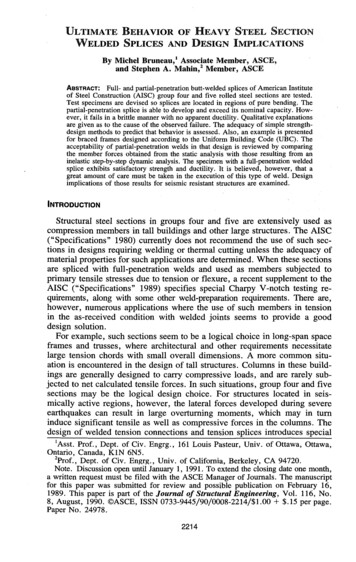
Transcription
U L T I M A T E BEHAVIOR OF H E A V Y S T E E L SECTIONW E L D E D SPLICES AND D E S I G N IMPLICATIONSBy Michel Bruneau,' Associate Member, ASCE,and Stephen A. Mahin,2 Member, ASCEABSTRACT: Full- and partial-penetration butt-welded splices of American Instituteof Steel Construction (AISC) group four and five rolled steel sections are tested.Test specimens are devised so splices are located in regions of pure bending. Thepartial-penetration splice is able to develop and exceed its nominal capacity. However, it fails in a brittle manner with no apparent ductility. Qualitative explanationsare given as to the cause of the observed failure. The adequacy of simple strengthdesign methods to predict that behavior is assessed. Also, an example is presentedfor braced frames designed according to the Uniform Building Code (UBC). Theacceptability of partial-penetration welds in that design is reviewed by comparingthe member forces obtained from the static analysis with those resulting from aninelastic step-by-step dynamic analysis. The specimen with a full-penetration weldedsplice exhibits satisfactory strength and ductility. It is believed, however, that agreat amount of care must be taken in the execution of this type of weld. Designimplications of those results for seismic resistant structures are examined.INTRODUCTIONStructural steel sections in groups four and five are extensively used ascompression members in tall buildings and other large structures. The AISC("Specifications" 1980) currently does not recommend the use of such sections in designs requiring welding or thermal cutting unless the adequacy ofmaterial properties for such applications are determined. When these sectionsare spliced with full-penetration welds and used as members subjected toprimary tensile stresses due to tension or flexure, a recent supplement to theAISC ("Specifications" 1989) specifies special Charpy V-notch testing requirements, along with some other weld-preparation requirements. There are,however, numerous applications where the use of such members in tensionin the as-received condition with welded joints seems to provide a gooddesign solution.For example, such sections seem to be a logical choice in long-span spaceframes and trusses, where architectural and other requirements necessitatelarge tension chords with small overall dimensions. A more common situation is encountered in the design of tall structures. Columns in these buildings are generally designed to carry compressive loads, and are rarely subjected to net calculated tensile forces. In such situations, group four and fivesections may be the logical design choice. For structures located in seismically active regions, however, the lateral forces developed during severeearthquakes can result in large overturning moments, which may in turninduce significant tensile as well as compressive forces in the columns. Thedesign of welded tension connections and tension splices introduces special'Asst. Prof., Dept. of Civ. Engrg., 161 Louis Pasteur, Univ. of Ottawa, Ottawa,Ontario, Canada, KIN 6N5.2Prof., Dept. of Civ. Engrg., Univ. of California, Berkeley, CA 94720.Note. Discussion open until January 1, 1991. To extend the closing date one month,a written request must be filed with the ASCE Manager of Journals. The manuscriptfor this paper was submitted for review and possible publication on February 16,1989. This paper is part of the Journal of Structural Engineering, Vol. 116, No.8, August, 1990. ASCE, ISSN 0733-9445/90/0008-2214/ 1.00 .15 per page.Paper No. 24978.2214
problems when heavy rolled sections are used in such cases. Unless reliableand economical methods for detailing welded tension connections are available, designers may be understandably reluctant to use members fabricatedfrom group four and five sections for these and other similar applications.In a number of instances, designers have used welded butt splices in tension members fabricated from group four and five sections. Unfortunately,several cases of partial or complete brittle fracture have been reported duringfabrication or construction (Bjorhovde 1987; Fisher and Pense 1987; "Welding Manual" 1983; Tuchman 1986). A wide variety of opinions have beenexpressed about the cause of this unsatisfactory performance. Some haveattributed these problems to the microstructural features and segregation (especially in the region contiguous to the flange and web) that occur in suchsections because of relatively high alloying, limited rolling, and high finishtemperatures employed in their manufacture. Others allege the unsatisfactoryperformance is a result of inadequate weld design or the use of improper orpoorly executed welding procedures. This situation casts considerable uncertainty over the safety and use of these types of members in tension.This paper presents the results of a testing program of partial- and fullpenetration butt-weld splices of typical group four and five sections, as presently fabricated by industry, and examines some analytical results to assessthe practical design implications of the observed behavior. A more detaileddiscussion of the various factors contributing to produce the behaviors observed may be found in Bruneau et al. (1987). This paper emphasizes thepractical consequences of the experimentally obtained results.SURVEY OF AVAILABLE DATAThere are several papers in the literature about welding of thick plates,welding-related problems, and general fabrication techniques to be used tominimize the occurrence of these problems. However, nearly all this information is of a qualitative nature ("Commentary" 1973; Blodgett 1977; Blodgett 1979; Doty 1987; Kaufmann and Stout 1983; Preece 1981; Yurioka etal. 1983). Relatively little quantitative information is available related to thefield performance and experimental behavior of tension splices in heavy section members.Detailed published reports of the findings of structural failure investigations are few (Bjorhovde 1987; Fisher and Pense 1987; Tushman 1986).Nevertheless, some prominent cases have been reported (e.g., Fisher andPense 1987), for which high residual stresses and particularly low notchtoughness of the base material are said to be responsible for failure at thejoints.Some tests of partial- and full-penetration tension splices in group foursections have been reported (Popov and Stephen 1976). These specimenswere tested in pure tension, but only the flanges were welded. Thus, thesespecimens avoided the high residual stress conditions induced by the weldingof the webs and present in the observed field failures. These test specimenswere able to develop their calculated capacities, but, in general, most sections exhibited very little ductility.TEST SPECIMEN CONFIGURATIONBecause of the aforementioned lack of quantitative data regarding the mechanical behavior of splices in group four and five sections, a series of ex2215
NOTES1. Provide 6" os specified instead ol 3 " os on standard detail.2 . A certified inspector is to be present during constructionand perform ultrasonic testing of the weld.1. Provide 7" os spec Iffedinstead of 3" os on standard detail.2. A certified inspector Is lo be present during constructionand perform ultrasonic testing of the weld.FIG. 1. Test Specimens: (a) Partial-Penetration Welded Splice Detail; (to) FullPenetration Welded Splice Detailperimental and analytical studies were undertaken. At the recommendationof an advisory panel, splice configurations considered were taken to be representative of those used in columns of buildings in seismically activeregions. Because full-penetration weldments have suffered the most fielddifficulties, they were the initial focus of these investigations. However, partial-penetration splices were investigated because they represent the substantial majority of all welds used for column splices. Because failures have beenobserved primarily in high-strength A572 grade 50 steel weldments, specimens for these experiments were fabricated from that steel. Standard A572grade 50 steel is not only believed to be more widely used, but has a lowernotch toughness than A36 grade steel, which makes it more susceptible tobrittle failure from a fracture-mechanics point of view. Special attention wasplaced on making the specimens representative of current engineering andfabrication practices. In these investigations, no efforts were made to modifythe metallurgical properties of the base metal or to develop special-purposeweld procedures.A partial-penetration weld of 50% of the flanges (t/2) and 50% of theweb (vv/2) is often specified by engineers in seismic regions [Fig. Ha)]. Italso corresponds to a minimum weld detail for some codes in specific circumstances. For example, the Uniform Building Code (1988) requires thisfor trasses (Sec. 2712g), and the Structural Engineers Association of Californa's "Recommended Lateral Force Requirements and Commentary" (1988)stipulates it for columns when there is any net calculable tensile force (Commentary Section 4-d). When full-penetration welds are specified for buildingcolumns, they are often detailed for construction reasons with the flangescompletely welded (t) and the web partially welded (w/2) [Fig. l(fc)]. Therefore, a partial-penetration connection and a full penetration one, as shownon Figs. 1(a) and (b), were selected for testing. The splice design details2216
FIG. 2. Specimen Set-Up for Partial-Penetration Test (Full-Penetration TestSpecimen Dimensions in Parentheses)selected in this testing program differ somewhat from those reported to havefailed in practice, but they are representative of construction in the westernUnited States.In an attempt to test as large a group of sections as possible, and to makethe specimens representative of column behavior under seismic loading conditions, it was decided to test specimens in bending. This also resulted inmore economical specimen preparation and facilitated tests involving loadreversals.A typical test set-up is illustrated in Fig. 2. The load applied by the widetesting machine head is split, through a spreader beam, into two point loads(rollers) acting on the specimen. This produces a uniform moment region inthe spliced region, in which damage is anticipated. As discussed by Bruneauet al. (1987). St.-Venant's effect, yield strength of the specimen's web, andwidth of the testing machine bed were considered in selecting specimen sizesand dimensions.In all cases, the connection to be tested was to represent a building columnsplice as executed in the field. The specimens were executed using standardfabricator details and procedures for field splices. Splice welds were executed in shop with the specimens upright, simulating as much as possiblefield conditions and procedures. Furthermore, inspectors witnessed theoperations, verified that American Welding Society (AWS) preheat, interpass, and post-heat requirements were respected, and performed ultrasonictesting of the base metal and of the welds to ensure conformity to AWSstandards ("Fundamentals" 1976). The weld process was flux-cored arc welding(FCAW), using E70 electrodes.Specimen One—Partial-Penetration WeldThe first specimen prepared and tested was the partial-penetration buttweld connecting a W14 X 500 to a W14 X 665. These are among the biggestrolled sections available from the AISC handbook, and are typically used ascolumns in the bottom stories of high-rise buildings.2217
The splice area was preheated to 250 F (121 C) and the interpass temperature was controlled during execution of the weld. The fabricator judgedthe ambient temperature (about 70 F, or 21 C) to be sufficiently warm sothe specimen could be air cooled. Visual inspection and ultrasonic inspectionof the base metal and weld were executed, and no defects were reported.Specimen Two—Full-Penetration WeldThe second specimen was a full-penetration butt weld connecting a W14X 370 to a W14 X 426. These were practically the largest sizes that couldbe accommodated on the testing machine with a full-penetration splice.The copes at the web-flange intersection were ground smooth, as was thecustom with the fabricator. This provided a smooth surface in the criticalintersection zone of the metal where the metallurgy is of inferior quality. Inpreviously reported failure case studies (Tuchman 1986), flame-cut copescreated a very jagged and brittle martensite surface that served as crack initiators. The grinding of these flame-cut cope holes should be noted wheninterpreting the test results. Another special feature was the root pass for theflange welds, which was located in the back-up bars.The specimen was preheated to 250 F (121 C). Interpass temperaturewas controlled. E70-311 low hydrogen electrodes were used. After completion of the weld, the splice area was wrapped with a thermal blanket to helpslow cooling overnight. Ambient temperatures at the time of welding wereestimated to be 60-70 F (15-21 C). Ultrasonic inspection of the base metaland weld revealed no defects.SPLICE WITH PARTIAL-PENETRATION WELDSDescription of TestingThe partial-penetration weld is obviously the weakest link along this specimen, as it is expected to transfer only about half the capacity of the smallerof the two sections connected to it. Any yielding in this first specimen wasexpected, therefore, to be concentrated in the steel immediately adjacent tothe weld area, since the yield stress of steel is presumably lower than thatof the weld material.Because of this, an X-Y plot of the moment-curvature relationship [as measured by clip-gauges on a 6-3/4 in. (171 mm) gauge length] at the centersplice was used to monitor the behavior of the splice as the loading programprogressed. Two other pairs of clip gauges were installed on each side ofthe central pair to allow curvatures to be deduced for the regions near thesplice. Although 29 channels of data were recorded for subsequent evaluation, only the clip-gauge results will be presented in this paper. All datawere recorded by a microcomputer-based data acquisition system.The first step in the loading program was to slowly, gradually load thespecimen through the elastic design range to its yield capacity, as evidencedby a small plastic offset in the moment-curvature plot. After this point thespecimen was to be unloaded and inverted for subsequent cyclic loading.Applied loads during the first step exceeded those corresponding to theoretical values of My/2 and Mp/2 for the smaller section, assuming a nominalyield stress of 50 ksi (345 MPa). Since the moment-curvature plot was stilllinear, loading was continued without apparent distress or yielding up to thetheoretical fully plastic state of a fictitious steel cross section created by the2218
FIG. 3. Failure of Partial-Penetration Welded Splice: (a) Global Specimen Failure; (/ ) Close-up of Failed Splicewelded surfaces. Following a 30 sec pause to visually inspect the specimenand the measurements, loading was increased to detect initial yielding. Themoment-curvature relationship remained practically linear to a moment ofapproximately 35,400 kips-in. (4,000 kN-m) [last digitized value is 34,992kips-in. (3,954 kN-m)] when a sudden and brittle failure occurred across theentire section through the weld [Figs. 3(a) and 3(b)].Once failure started in the tension (bottom) flange, the part of the sectionremaining intact was unable to accommodate the imposed displacement. Thefailure then quickly progressed through the whole section. The erection platedid not appear to restrain or stabilize the failure once it initiated. The erec2219
36 0001;28 900/2Za.5Z21600 :// /14 400/2/ON WI4«66SON WI4K5001 K I P - I N - 113 tN-mm1 RAD/IN 0.039 RAD/mms7 200 /r00.00/i0.0Sl0.10.l.0.15i.0.200.23CURVATURES AROUND THE SPLICE (xO 001 RAD/IN)FIG. 4. Moment-Curvature Relationship from Clip Gauges for Partial-PenetrationSpecimention bolts were sheared suddenly and thrown with considerable energy awayfrom the splice. Temperature at time of testing was around 55 F (13 C).Experimentally Recorded ResultsDetailed description of the failure surface, estimates of stress-intensity factor Kt at failure, and presentation of all recorded information during testingare beyond the scope of this paper and presented elsewhere (Bruneau et al.1987). It is nevertheless noteworthy that inspection of the failure surface (A.Collins, welding consultant, private communication, 1985) indicated a lackof fusion between some weld passes, and a lack of penetration and fusionof the root passes. Nonetheless, it is believed that even a better weld wouldhave fractured in a brittle mode.From the recorded data, the most meaningful information, shown on Fig.4, was provided by three pairs of clip gauges with gauge lengths of approximately 6 in. These clip gauges measured global yielding effects in thesplice area. The moment-curvature relationship derived from the clip gaugeson the W14 X 665 remains perfectly elastic, and is almost identical to thetheoretical one. As the moments get above 28,800 kips-in. (3,254 kN-m),a slight softening of the moment-curvature relation can be observed for theother two regions. Local yielding due to residual stresses is likely the causeof the softening observed for the W14 x 500. However, at failure, none ofthe measured curvatures exceeded the predicted elastic values by more than10%.Analysis of Probable Stresses at FailureStresses can be estimated from the observed data in a few different ways.The fact that linearity was preponderant during the test permits the use ofsome simplifying assumtions. For example, estimates of maximum stressesat cross sections away from the splice on the partial-penetration specimencan be obtained from the strains measured and by assuming linear-elastic2220
behavior. The maximum stresses thus obtained at the time of failure were30.8 ksi (212 MPa) and 42.3 ksi (292 MPa) on the W14 X 665 and W14X 500 sections, respectively. These stresses do not exceed the nominal yieldvalue for sections away from the splice.This approach is, of course, inaccurate near the weld since it completelyneglects the stress-concentration factor created by the partial penetration, aswell as the initial residual stresses. Nonetheless, it is interesting to estimatethe strength of the splice as one might do in design. Plane sections are assumed to remain plane, and either linear-elastic or simple plastic materialproperties are used. For these estimates, the material is assumed to yield at50 ksi (345 MPa). If one estimated the capacity of the splice by taking onehalf of the yield capacity (My) of the smaller section, the experimentallymeasured capacity is 59% greater. The measured capacity is also 35% greaterthan Mp/2 of the smaller section. A more detailed analysis based on the fullplastic-moment capacity of the welded portions of the smaller section resultsin an estimate 20% less than the measured capacity. Thus, the section strengthis conservatively estimated by standard methods.Stresses also can be computed using such methods at the observed failuresection. This can have a significant effect here because of the large difference in flange thicknesses between the two sections. Should the smoothedweld transition as used on the specimen be included in the calculations, thestresses computed again using simplified elastic analysis methods at variouspotential failure surface sections are significantly lower than the nominalyield value, ranging from 43-45 ksi (296-310 MPa), depending on the selected critical surface, or approximately 90% of the nominal yield capacity.This implies that these critical sections would have remained elastic at failure. Obviously, all these methods neglect the very important effects of stressconcentration and residual stresses. However, the thickening of the sectiondue to the transition welds provides one reason for the apparent high capacityof the splice.To gain a qualitative understanding of the stresses near the splice at thetime of failure, elastic finite element procedures can be used. The presenceof discontinuities in the mesh makes the results inexact, but it allows oneto gain a feeling for the stress distribution across the depth of the sectionnear the weld. To estimate the true stresses at the tip of the crack, a veryfine mesh would be required in that critical zone and a more refined materialmodel would also be needed, considering nonlinearity and fracture. Fracturemechanics methods could serve the same purpose. In this analysis, the tension flange is modeled as a plane strain slice continuously supported at theweb-flange location. The two-dimensional model neither reflects the variations induced by shear lag, nor accounts for residual stresses.Results for a model (Fig. 5) where a progressive change of thickness isintroduced, as expected in a properly executed weld, are presented here.Other models were investigated elsewhere (Bruneau et al. 1987) to assessthe effect of different transition configurations. Smoothening the weld doesnot change the basic nature of the results, but helps reduce the overall stressesand discontinuity effects.Loads (stresses) were imposed to approximate the states of stress in theflanges away from the splice at the time of failure. Results obtained aresummarized on Fig. 5, and emphasize the fact that, while uniform varyingstresses would be expected away from the weld, very high stresses would2221
r*-Ar»Br*-C-» AL»-BuJiSL29.729.128427 �—A-AD-0s-t(ON W I 4 i S 0 0 )I KSI 6.895 MPaFIG. 5. TU Stress Magnitudes and Distribution Profile for Finite Element Analysis Results along Selected Cross Sectionsconcentrate at the tip of the crack. Stresses much higher than yield are predicted, thereby violating the assumptions in the analyses.The finite element results clearly reveal the stress-concentration effect produced by the unwelded half of the flange. It effectively acts like an initialcrack. The maximum stresses occur near the root of the weld, not at the topwhere they are predicted to occur by traditional methods of calculation.Although the previous discussion mainly emphasized the presence of excessive stress concentration in the flange due to the cracklike effect of theunwelded part of the flange, it must be realized that the brittle failure wasapparently a result of a combination of factors. As discussed by Bruneau etal. (1987), other significant factors include bad fusion of the weld passes,critical weld configuration, and low effective gauge length around the weld.The design capacity of the section has been significantly exceeded. Nevertheless, this failure is rather disconcerting as it occurs in the weld suddenly,without warning. Moreover, conventional design methods not based on fracture mechanics ignore the cracklike discontinuity inherent in partial-penetration welds when assessing local stresses.Some Design Implications for Seismic Resistant Braced FramesPartial-penetration column splices, such as those tested here, are mandatedby several codes (Uniform 1988) for structures in seismic zones when anynet tensile load is computed. Using conventional allowable-stresses design2222
Thl From« W/0Brocmg Mult BtAbla To Resiit25%Of Thil Lood.I-52JI FT * 0,3046 mIKIP 4.448kNFIG. 6. Braced-Frame System Designed by the Uniform Building Code: (a) FloorPlan; (b) Geometry, Splice Location, and Applied Forcesmethods, it is possible to design such a building in the belief these columnsplices would not be subjected to tensile loads greater than Py / 2 or to moments greater than Mp/2. In such cases, half-penetration welds may providea functional and economical design solution. However, actual earthquakeinduced actions can exceed these values in certain cases.To illustrate this, an eight-story braced frame was designed using the 1985edition of the Uniform Building Code {Uniform 1985). The geometry of thestructure and the resulting design are shown in Figs. 6(a) and 6(b). No efforts were made to obtain large sections similar to the ones tested duringthis investigation (W14 X 665 and W14 X 500), but this could have beenTABLE 1. Eight-Story Braced Frame: UBC Analysis'MAXIMUM FORCES FROM UBC 82 '-457-341-236-144-70-15Tension 162-145-122-95-63ALLOWABLE 6-129-114-63Braces286—177—177—"Component dimensions: Columns, first and second stories, W12 X 96; third and fourth stories,W12 X 65; fifth through eighth stories, W12 X 40. Beams, first and second stories, W12 X 106;third and fourth stories, W12 X 96; fifth story, W12 x 87; sixth story, W12 x 79; seventh and eighthstories, W12 X 45. Braces, first through fourth stories, W12 X 53; fifth story, W12 X 50; sixthstory, W12 X 45; seventh and eighth stories, W12 X 40. Column splices occur at the third, fifth,and seventh stories.2223
done simply by changing the floor plan and building height. In this design,W12-compact sections were used for all structural members (Table 1) tofacilitate detailing of the connections.The floor plan considered in this example transfers very little of the deadand live loads to the columns of the braced frame, especially compared tothe axial forces due to the lateral equivalent force calculated by the UniformBuilding Code (UBC). Dead loads on the braced bent were 30 kips (133kN) per story, and live loads were 15 kips (67 KN) per story, distributedas shown in Fig. 6(b). The UBC seismic forces where obtained using thefollowing equation.V ZIKCSW .(1)05in which Z 1.0; / 1.0; K 0.8; S 1.5; C 1/15(T) ; and W 3,850 kips (17,125 kN). As a result, V 275 kips (1,223 kN).The resulting load distribution is shown in Fig. 6(b). The period T of thestructure was computed to be 1.25 sec after a few design iterations. Theframe design satisfies all of the UBC strength and stiffness requirements.The 1.25 load increase factor prescribed for braced frames and the 1.33increase in allowable stress permitted in seismic design have both been conservatively omitted in this example since they practically cancel. The bareframe (without bracing) is able to resist 25% of the loads applied, as requiredfor the use of a K factor of 0.8. Resulting member design axial forces areshown in Table 1. Note that maximum compression and tension forces resulted from different load cases.All splices were located in regions where the maximum calculated tensionforce (from UBC analysis) was less than one-half of the allowable tensionload of the smaller section at the splice. Moments at splice locations werenegligible. Therefore, a designer might use partial-penetration butt welds forthe column splices.Several inelastic dynamic analyses of this frame were performed. Stiffness-proportional viscous damping was chosen, with 2% of critical dampingprovided at the first mode period, the post-yield strain-hardening ratio forthe members was taken as 0.05, and the yield stress was assumed to be 50ksi (345 MPa). In the example presented here, buckling of the braces alsooccurred at 50 ksi (345 MPa), corresponding to very stocky braces. Resultsfor more slender braces are presented elsewhere (Bruneau et al. 1987). Theunsealed N-S component of the 1940 El Centra earthquake was used as theinput for the system (0.34g peak acceleration). To illustrate the critical condition for the splices, no live loads were included in this analysis, and only80% of the design dead load was considered simultaneously with the earthquake. For these analyses, the splices were assumed to be able to transferthe full capacity of the members connected, and failures in the splices ofcolumns were not modeled in the analysis.Time histories of the axial loads at the third- and fifth-floor splices areplotted in Fig. 7. These splices reached their failure loads nearly simultaneously; at only 1.96 sec after initiation of earthquake motion. Numericalvalues for the resulting demands are presented in Table 2. Failure of thesplices was defined here to occur when an axial load developed equal to Py/2 of the smaller section at the splice. In light of the results of the testingprogram, it could have been increased slightly, delaying the failure by afraction of a second. The rest of the column response in Fig. 7 shows these2224
Mi WilI.u.mi A""fujo-120012001 kip 4 . 4 4 8 k N12150TIME (sec.)FIG. 7. Time History of Axial Force in Third-Story Splice (Top Graphs) and FifthStory Splice (Bottom Graphs)—Left and Right Columns (F Predicted FailureForce Level)large axial tensile forces are demanded many times. The gravity loads in thecolumns (see time zero in Fig. 7) are very low compared to the fluctuationsassociated with the dynamic excitation. Consequently, it is important to notethat even if full dead and live load were used, the same results would occurwith the initial failure slightly delayed.Analyses were also performed using more slender braces with a criticalbuckling stress of 25 ksi (172 MPa). These additional analyses producedsimilar results with larger inelastic demands on the columns, coupled withlarge inelastic demands on the bracing system. Failure of the splices occurredTABLE 2.Eight-Story Braced Frame: Nonlinear Analysis"MAXIMUM FORCES FROM NONLINEAR 241StoryPy/2 of smallestsection at splice(6)——478—295—295—'Component dimensions: Columns, first and second stories, W12 x 96; third and fourthstories, W12 x 65; fifth through eighth stories, W12 X 40. Beams, first and secondstories, W12 x 106; third and fourth stories, W12 X 96; fifth story W12 x, 87; sixthstory, W12 x 79; seventh and eighth stories, W12 x 45.
the specimen could be air cooled. Visual inspection and ultrasonic inspection of the base metal and weld were executed, and no defects were reported. Specimen Two—Full-Penetration Weld The second specimen was a full-penetration butt weld connecting a W14 X 370 to a W14 X 426. These were practically the largest sizes that could



